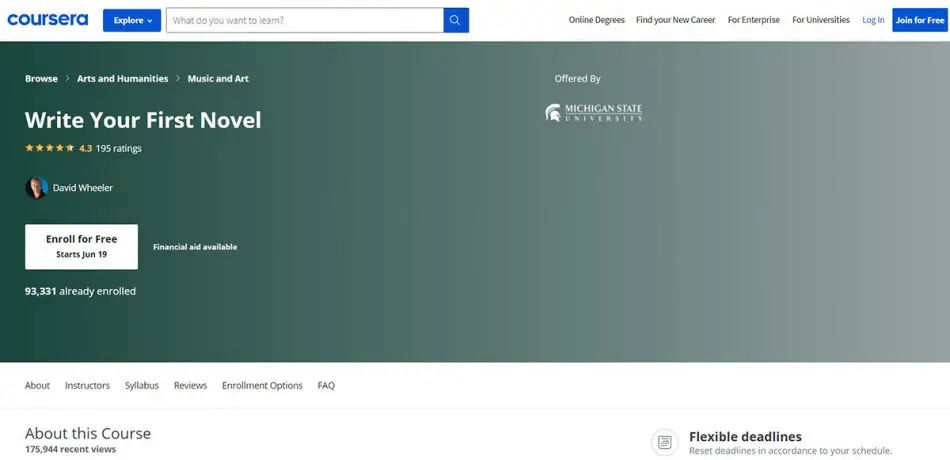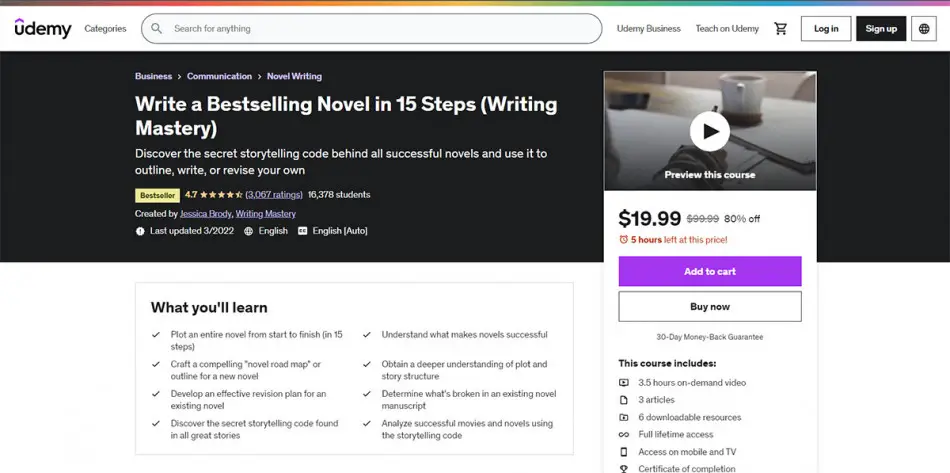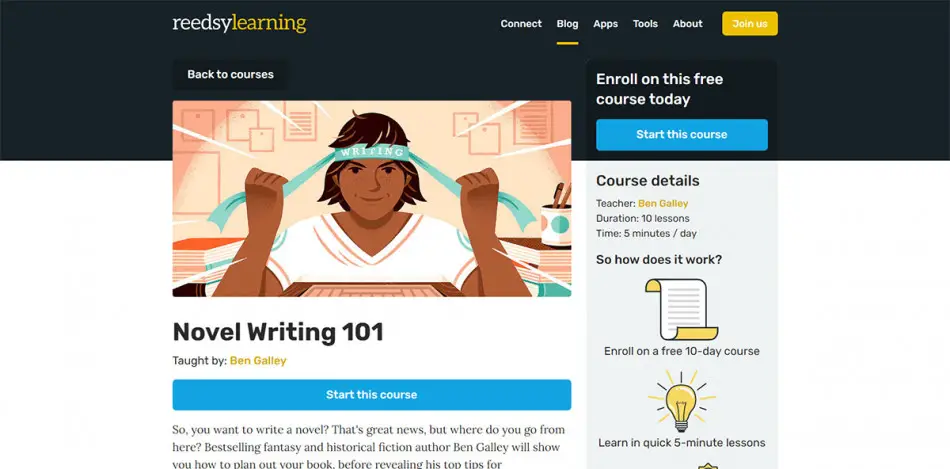Writing a novel is an exhilarating journey. Though it has its ups and downs, and moments of sheer joy intertwined with moments of pure frustration, ultimately,
it is a journey that is worth taking. A lot of you might have wonderful stories floating around in your heads, but you might not know how to get them down on paper.
Here are the 6 steps involved in teaching yourself to write a novel – create an idea for a story, envision a world where the story takes place, bring a few memorable characters to life, outline the key scenes and the climax, write the first draft, and lastly, revise and edit the story.
Though this is a simple structure, many of the greatest stories ever told have followed it.
In this guide, we’ll help you learn the ropes of novel writing so that you can get your story out there for the world to see.
We’ll take you through each step of the process, from idea to finished product.
Are you ready to start your journey?
6 Steps to Teach Yourself How to Write A Novel
People have been writing stories since the invention of language. It’s a fundamental part of being human.
So, it’s clear that you don’t need expensive classes or a college degree to write a novel.
All you need is patience, practice, and a willingness to learn.
For those of you who want to take the plunge and teach yourselves how to write a novel, here are six steps to get you started.
-> Read Also What Is An Autodidact?
1. Creating an Idea for a Story

The first step to writing a novel (or anything for that matter) is by creating an idea. It can be anything, really – a thought, an experience, or even just a daydream.
What matters is that you have something to start with. Here are a couple of ways you can come up with an idea for a great novel.
- Write about a story from your own life: This is a great way to get started because you can draw on your own experiences and observations. For e.g., David Copperfield by Charles Dickens and Little Women by Louisa May Alcott are both novels loosely based on the authors’ own lives.
- Write about the life of someone you know: This is another great way to generate ideas. It could be a family member, a friend, or even a celebrity. The key is to write about someone you know well enough to be able to create a believable and interesting story.
- Reinvent a mythological story or a fairytale: This is a fun way to put your own spin on a familiar story. The best part is that there are already built-in characters and plots that you can use as a starting point. For e.g., the Percy Jackson series by Rick Riordan is a modern retelling of Greek mythology.
- Choose a historical event: This is a great way to learn about a particular time period and write an exciting story at the same time. For e.g., The Tattooist of Auschwitz by Heather Morris is based on a true story set during the Holocaust.
- Look around you: The world is full of stories just waiting to be told. All you have to do is open your eyes and start paying attention. Look for news stories, real-life events, or even everyday situations that could be turned into a novel.
Once you have your idea, it’s time to start breathing life into it.
2. Envision A World Where the Story Takes Place
The next step is to start building the world where your story will take place. This is where you get to decide things like the time period, the location, and the culture.
Worldbuilding is an important part of writing a novel because it helps to create a believable and immersive setting.
It draws your readers in and makes them feel like they’re a part of the story.
Here are a few things to keep in mind when you’re creating the world for your story.
- Be specific: The more specific you are, the easier it will be for readers to imagine the world you’ve created. Which sounds better – “a small town in the Midwest” or “Elmwood, Indiana in the late 1800s“?
- Choose a time period: This is a great way to set the tone and mood of your story. For e.g., a historical novel set during the Victorian era will have a very different feel from a contemporary novel set in present-day New York City.
- Create contrast: Don’t be afraid to mix things up. A little bit of contrast can go a long way in making your world more interesting. For e.g., you could have a story set in a post-apocalyptic world that’s full of hope and possibility.
- Make it consistent: Once you’ve decided on the rules of your world, stick to them. Inconsistencies will jar your readers out of the story and make them lose faith in your world. For e.g., don’t have a character use a cellphone if you’ve already established that there’s no such technology in your world.
- Leave room for exploration: As you’re writing, there will be things that you discover about your world that you didn’t know before. Leave room for these discoveries so that your story can organically grow and develop.
Remember, your world doesn’t have to be perfect: It’s okay if it’s not. In fact, a little bit of imperfection can make your story more relatable and believable.
If you want inspiration, these are some of the best novels that showcase brilliant worldbuilding – The Lord of the Rings by J.R.R. Tolkien, The Harry Potter Series by J.K. Rowling, and Dune by Frank Herbert.
Now that you have the world for your novel, it’s time to start creating the characters who will inhabit it.
3. Bring A Few Memorable Characters to Life
Characters are the heart and soul of a novel. They’re the ones who drive the story forward and make it come to life.
Creating believable and relatable characters is one of the most important parts of writing a novel.
After all, your readers need to be invested in your characters in order to care about what happens to them.
Let’s take a look at some of the most important character roles in a novel.
| Character Roles | Description | Examples |
| The Protagonist | The protagonist is the main character of your story – the one who’s going on the journey and experiencing all the challenges firsthand. | Frodo in The Lord of the Rings Katniss in The Hunger Games. |
| The Antagonist | The antagonist is the character who’s standing in the way of the protagonist and preventing them from achieving their goal. | Voldemort in The Harry Potter series Professor Moriarty in the Sherlock Holmes stories. |
| The Love Interest | The love interest is a character who plays an important role in the protagonist’s journey, often serving as a source of support and motivation. | Annabeth in Percy Jackson Peeta/Gale in The Hunger Games. |
| The Deuteragonist | The deuteragonist is the second-most important character in your story. They have their own goals and motivations, and their story arc is often intertwined with the protagonist’s. | Hermione in Harry Potter Horatio in Hamlet. |
| The Mentor | The mentor is a wise and experienced character who helps to guide the protagonist on their journey. | Dumbledore in Harry Potter Yoda in Star Wars. |
| The Sidekick | The sidekick is a close friend or confidante of the protagonist who accompanies them on their adventures. | Samwise Gamgee in The Lord of the Rings Dr. Watson in the Sherlock Holmes stories. |
| Tertiary Characters | Tertiary characters are supporting characters who play a smaller role in the story. Although they do not have as much screen time as the other characters, they are still important in advancing the plot. | Father Zosima in The Brothers Karamazov the Dwarves in The Hobbit. |
You can use all of these character roles in your novel, or you can mix and match them to create something unique.
Just remember that each character should have their own goal, motivation, and backstory.
4. Outline the Key Scenes and The Climax

Once you have your characters and your world, it’s time to start plotting out the key scenes in your story.
The best way to do this is to create an outline. This will help you keep track of what needs to happen in each scene and how it will propel the story forward.
Your outline should include:
- The story’s inciting incident (the event that sets everything in motion)
- The major plot points (the key scenes that advance the story)
- The climax (the moment when the protagonist confronts the antagonist and tries to achieve their goal)
- The resolution (the aftermath of the climax and the conclusion of the story)
Creating an outline will help you stay on track as you write, and it will make the editing process much easier. So take your time and plan out each scene carefully.
Here are a few examples of scenarios you can use in your novel. Feel free to use one of these, or come up with something entirely different.
- The protagonist discovers a dark secret about the antagonist.
- The love interest is kidnapped by the antagonist.
- The mentor is killed by the antagonist, thus sending the protagonist on a quest for revenge.
- The deuteragonist betrays the protagonist, leading to a final showdown between the two.
- The sidekick is gravely injured and the protagonist must find a way to save them.
Once you’ve planned out your key scenes, you’re ready to start writing your novel!
5. Write the First Draft
Now comes the fun part: it’s time to start writing! Remember, the first draft is all about getting your ideas down on paper (or screen).
Don’t worry about making it perfect. Just focus on getting the story down and fleshing out your characters and world. You can always go back and make changes later.
As you write, keep the following things in mind:
- Make sure each scene advances the plot and moves the story forward.
- Show, don’t tell. Use vivid descriptions to bring your characters and world to life.
- Write from different points of view to add depth and dimension to your story.
- Be consistent with your grammar, spelling, and punctuation.
- Have someone else read your draft and give you feedback.
The first draft is the hardest, but it’s also the most important. So take your time and make sure you’re happy with what you’ve written before moving on to the next step.
6. Revise and Edit the Story

Immediately after finishing your first draft, put it away for a while. Take a break from it and come back later with fresh eyes.
This will help you spot any errors or inconsistencies.
When you’re ready, it’s time to start revising and editing your story.
This is where you’ll make all the necessary changes to make your novel shine.
Here are a few things to keep in mind as you revise:
- Is the story well-paced? Do the scenes flow smoothly from one to the next?
- Are the characters well-developed and believable? Do their actions make sense?
- Is the plot clear and easy to follow? Does it make sense?
- Are there any holes in the story that need to be filled in?
- Have you used strong verbs and vivid adjectives to bring the story to life?
- Is the dialogue natural and realistic?
- Have you proofread the story for grammar, spelling, and punctuation errors?
If you’ve completed everything on this checklist, your novel is now ready for publication. And in the process of writing and editing, you’ve taught yourself the skills you need to write a novel on your own!
-> Learn More about Self-Learning vs. Classroom Learning: Which Is Better?
Best Places to Learn How to Write A Novel on Your Own

Today, there are hundreds of online courses and resources dedicated to the art of novel writing.
Here are a few of our favorites:
1) Write Your First Novel – Coursera

Perhaps the best place to start is with Coursera’s “Write Your First Novel” course.
This comprehensive 26-week course will take you through all the steps of writing a novel, from planning and outlining to revision and editing.
Each week will have you writing a few pages of your novel, and by the end of the course, you’ll have a 50,000-word completed manuscript of your first novel.
You can even get feedback from other students in the class.
The course is taught by acclaimed writer David Wheeler, and it’s available for free with a Coursera account.
URL: https://www.coursera.org/learn/write-your-first-novel
2) Write a Bestselling Novel in 15 Steps (Writing Mastery) – Udemy

What would it be like to learn the art of novel writing from a best-selling author who has published books in over 23 countries?
With this Udemy course, you can find out.
In “Write a Bestselling Novel in 15 Steps (Writing Mastery),” author and writing coach Jessica Brody will take you through her proven process for writing a bestselling novel.
You’ll learn how to come up with ideas, develop characters, outline your story, write compelling dialogue, and much more.
By the end of the course, you’ll have everything you need to write a bestselling novel of your own.
URL: https://www.udemy.com/course/write-a-bestselling-novel-in-15-steps-writing-mastery
3) Novel Writing 101 – Reedsy

This free 10-day course from Reedsy will teach you everything about all the basic skills you need to write a novel.
And the best part? The lessons are designed in the form of entertaining, bite-sized emails that you can read and digest at your own pace.
So if you’re looking for a fun and easy way to learn how to write a novel, this is the course for you.
URL: https://blog.reedsy.com/learning/courses/writing/novel-writing-101
Frequently Asked Questions (FAQs)

Here are some of the most commonly asked questions about writing a novel.
Q.1. How long is a novel?
A. Although there is no formal word count, most experts agree that a novel should be of a minimum of 50,000 words.
Most standard novels are between 80,000 to 100,000 words.
Q.2. Can you write a novel with no writing experience?
A. Yes! Anyone can write a novel, regardless of experience. All you need is a great story idea, some determination, and the willingness to put in the hard work.
Of course, a good understanding of the craft of writing will take your novel to the next level, but it’s not necessary to get started.
Q.3. How do I get my novel published?
A. Once you’ve written and edited your novel, the next step is to find a literary agent or publishing house that will be interested in it.
You can send them an email along with a short synopsis and the first few chapters of your novel.
If they’re interested, they’ll request to see the rest of your manuscript.
-> Learn more about the 7 best websites for self-learning
Final Thoughts
We hope this article has inspired you to start writing your own novel. Every great story starts with a single letter on a blank page, so what are you waiting for?
Go out there and start writing today!
The world is waiting for your story.






